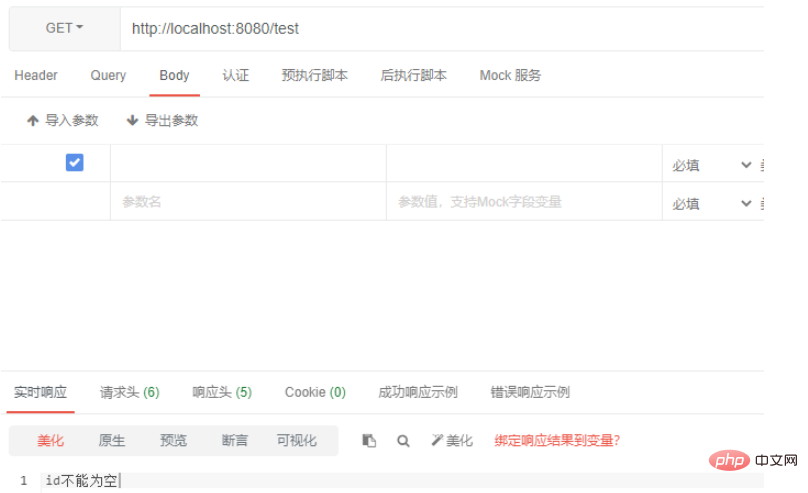SpringBoot 매개변수를 확인하는 방법
- PHPz앞으로
- 2023-05-14 22:04:121256검색
使用传统方式的弊端
public String addUser(User user) {
if (user == null || user.getId() == null || user.getAccount() == null || user.getPassword() == null || user.getEmail() == null) {
return "对象或者对象字段不能为空";
}
if (StringUtils.isEmpty(user.getAccount()) || StringUtils.isEmpty(user.getPassword()) || StringUtils.isEmpty(user.getEmail())) {
return "不能输入空字符串";
}
if (user.getAccount().length() < 6 || user.getAccount().length() > 11) {
return "账号长度必须是6-11个字符";
}
if (user.getPassword().length() < 6 || user.getPassword().length() > 16) {
return "密码长度必须是6-16个字符";
}
if (!Pattern.matches("^[a-zA-Z0-9_-]+@[a-zA-Z0-9_-]+(\\.[a-zA-Z0-9_-]+)+$", user.getEmail())) {
return "邮箱格式不正确";
}
// 参数校验完毕后这里就写上业务逻辑
return "success";
}这样做确实没有什么问题,而且排版也工整,但代码太繁琐了,如果有几十个字段要校验,那这个方法里面将会变得非常臃肿,实在不够优雅。下面我们就来讲讲如何使用最优雅的方式来解决。
引入依赖
<dependency> <groupId>org.springframework.boot</groupId> <artifactId>spring-boot-starter-validation</artifactId> </dependency>
注解说明
| 注解 | 说明 |
|---|---|
| @AssertFalse | 被注解的元素必须为 false |
| @AssertTrue | 被注解的元素必须为 true |
| @DecimalMax(value) | 被注解的元素必须是一个数字,其值必须小于等于指定的最大值 |
| @DecimalMin(value) | 被注解的元素必须是一个数字,其值必须大于等于指定的最小值 |
| @Digits (integer, fraction) | 被注解的元素必须是一个数字,其值必须在可接受的范围内 |
| @Null | 被注解的元素必须为空 |
| @NotNull | 被注解的元素必须不为空 |
| @Min(value) | 被注解的元素必须是一个数字,其值必须大于等于指定的最大值 |
| @Max(value) | 被注解的元素必须是一个数字,其值必须小于等于指定的最大值 |
| @Size(max, min) | 被注解的元素的长度必须在指定的范围内 |
| @Past | 被注解的元素必须是一个过去的日期 |
| @Future | 被注解的元素必须是一个未来的日期 |
| @Pattern(value) | 被注解的元素必须符合指定的正则表达式 |
下面我们以此来在业务中实现
一、对实体类进行校验
1、entity
@Data
public class User {
@NotNull(message = "用户id不能为空")
private Long id;
@NotNull(message = "用户账号不能为空")
@Size(min = 6, max = 11, message = "账号长度必须是6-11个字符")
private String account;
@NotNull(message = "用户密码不能为空")
@Size(min = 6, max = 11, message = "密码长度必须是6-16个字符")
private String password;
@NotNull(message = "用户邮箱不能为空")
@Email(message = "邮箱格式不正确")
private String email;
}2、controller
@RestController
public class UserController {
@PostMapping("/addUser")
public void addUser(@RequestBody @Valid User user) {
//业务
}
}3、编写全局统一异常处理
import org.springframework.validation.ObjectError;
import org.springframework.web.bind.MethodArgumentNotValidException;
import org.springframework.web.bind.annotation.ExceptionHandler;
import org.springframework.web.bind.annotation.RestControllerAdvice;
import javax.validation.ConstraintViolation;
import javax.validation.ConstraintViolationException;
import java.util.stream.Collectors;
/**
* 全局异常处理
*
* @author master
*/
@RestControllerAdvice
public class ExceptionConfig {
/**
* 参数为实体类
* @param e
* @return
*/
@ExceptionHandler(value = MethodArgumentNotValidException.class)
public String handleValidException(MethodArgumentNotValidException e) {
// 从异常对象中拿到ObjectError对象
ObjectError objectError = e.getBindingResult().getAllErrors().get(0);
// 然后提取错误提示信息进行返回
return objectError.getDefaultMessage();
}
/**
* 参数为单个参数或多个参数
* @param e
* @return
*/
@ExceptionHandler(value = ConstraintViolationException.class)
public String handleConstraintViolationException(ConstraintViolationException e) {
// 从异常对象中拿到ObjectError对象
return e.getConstraintViolations()
.stream()
.map(ConstraintViolation::getMessage)
.collect(Collectors.toList()).get(0);
}
}然后我们使用apipost测试

二、针对单个参数进行校验
import org.springframework.validation.annotation.Validated;
import org.springframework.web.bind.annotation.GetMapping;
import org.springframework.web.bind.annotation.PostMapping;
import org.springframework.web.bind.annotation.RestController;
import javax.validation.constraints.NotNull;
@RestController
@Validated
public class TestController {
@GetMapping("/test")
public void test(@NotNull(message = "id不能为空") Integer id) {
}
}然后我们使用apipost测试

三、分组校验
场景:在新增时我们需要id为空,但修改时我们又需要id不为空,总不可能搞两个类吧,这时候分组校验的用处就来了
1、entity
import lombok.Data;
import javax.validation.constraints.Email;
import javax.validation.constraints.NotNull;
import javax.validation.constraints.Size;
@Data
public class User {
public interface Insert{
}
public interface Update{
}
@NotNull(message = "用户id不能为空",groups = Update.class)
@Null(message = "用户id必须为空",groups = Integer.class)
private Long id;
private String account;
private String password;
private String email;
}2、controller
@PostMapping("/add")
public void add(@RequestBody @Validated(User.Insert.class) User user) {
}添加时就用User.Insert.class,修改时就用User.Update.class
四、自定义分组校验
场景:当type为1时,需要参数a不为空,当type为2时,需要参数b不为空。
1、entity
import com.example.demo.provider.CustomSequenceProvider;
import lombok.Data;
import org.hibernate.validator.group.GroupSequenceProvider;
import javax.validation.constraints.NotEmpty;
import javax.validation.constraints.Pattern;
@Data
@GroupSequenceProvider(value = CustomSequenceProvider.class)
public class CustomGroup {
/**
* 类型
*/
@Pattern(regexp = "[A|B]" , message = "类型不必须为 A|B")
private String type;
/**
* 参数A
*/
@NotEmpty(message = "参数A不能为空" , groups = {WhenTypeIsA.class})
private String paramA;
/**
* 参数B
*/
@NotEmpty(message = "参数B不能为空", groups = {WhenTypeIsB.class})
private String paramB;
/**
* 分组A
*/
public interface WhenTypeIsA {
}
/**
* 分组B
*/
public interface WhenTypeIsB {
}
}2、CustomSequenceProvider
import com.example.demo.controller.CustomGroup;
import org.hibernate.validator.spi.group.DefaultGroupSequenceProvider;
import java.util.ArrayList;
import java.util.List;
public class CustomSequenceProvider implements DefaultGroupSequenceProvider<CustomGroup> {
@Override
public List<Class<?>> getValidationGroups(CustomGroup form) {
List<Class<?>> defaultGroupSequence = new ArrayList<>();
defaultGroupSequence.add(CustomGroup.class);
if (form != null && "A".equals(form.getType())) {
defaultGroupSequence.add(CustomGroup.WhenTypeIsA.class);
}
if (form != null && "B".equals(form.getType())) {
defaultGroupSequence.add(CustomGroup.WhenTypeIsB.class);
}
return defaultGroupSequence;
}
}3、controller
@PostMapping("/add")
public void add(@RequestBody @Validated CustomGroup user) {
}五、自定义校验
虽然官方提供的校验注解已经满足很多情况了,但还是无法满足我们业务的所有需求,比如校验手机号码,下面我就以校验手机号码来做一个示例。
1、定义校验注解
@Target({ElementType.FIELD})
@Retention(RetentionPolicy.RUNTIME)
@Constraint(validatedBy = PhoneValidator.class)
public @interface Phone {
String message() default "手机号码格式有误";
Class<?>[] groups() default {};
Class<? extends Payload>[] payload() default {};
}注:groups和payload是必须要写的,Constraint是使用哪个类来进行校验。
2、实现注解
import javax.validation.ConstraintValidator;
import javax.validation.ConstraintValidatorContext;
import java.util.regex.Pattern;
/**
* @author master
*/
public class PhoneValidator implements ConstraintValidator<Phone, Object> {
@Override
public boolean isValid(Object telephone, ConstraintValidatorContext constraintValidatorContext) {
String pattern = "^1[3|4|5|6|7|8|9]\\d{9}$";
return Pattern.matches(pattern, telephone.toString());
}
}最后直接用到参数前面或者实体类变量上面即可。
六、嵌套校验
当某个对象中还包含了对象需要进行校验,这个时候我们需要用嵌套校验。
@Data
public class TestAA {
@NotEmpty(message = "id不能为空")
private String id;
@NotNull
@Valid
private Job job;
@Data
public class Job {
@NotEmpty(message = "content不能为空")
private String content;
}
}七、快速失败
Spring Validation默认会校验完所有字段,然后才抛出异常。可以通过配置,开启Fali Fast模式,一旦校验失败就立即返回。
import org.hibernate.validator.HibernateValidator;
import org.springframework.context.annotation.Bean;
import org.springframework.context.annotation.Configuration;
import javax.validation.Validation;
import javax.validation.Validator;
import javax.validation.ValidatorFactory;
@Configuration
public class FailFastConfig {
@Bean
public Validator validator() {
ValidatorFactory validatorFactory = Validation.byProvider(HibernateValidator.class)
.configure()
// 快速失败模式
.failFast(true)
.buildValidatorFactory();
return validatorFactory.getValidator();
}
}注意事项
SpringBoot 2.3.x 移除了validation依赖需要手动引入依赖。
위 내용은 SpringBoot 매개변수를 확인하는 방법의 상세 내용입니다. 자세한 내용은 PHP 중국어 웹사이트의 기타 관련 기사를 참조하세요!
성명:
이 기사는 yisu.com에서 복제됩니다. 침해가 있는 경우 admin@php.cn으로 문의하시기 바랍니다. 삭제

